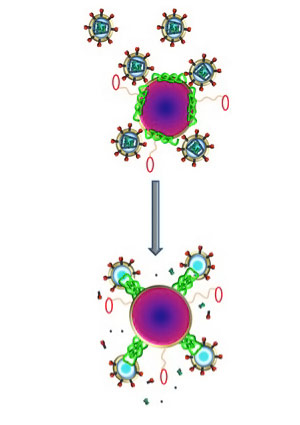Skip to comments.
Nanoparticles Carrying Melittin Kill HIV [Bee Venom]
http://scitechdaily.com ^
| March 8, 2013
| by Staff
Posted on 03/12/2013 12:26:18 PM PDT by Red Badger
n a newly published study, scientists from Washington University School of Medicine show how nanoparticles carrying melittin fuse with HIV, killing the virus and leaving surrounding cells unharmed.
Nanoparticles carrying a toxin found in bee venom can destroy human immunodeficiency virus (HIV) while leaving surrounding cells unharmed, researchers at Washington University School of Medicine in St. Louis have shown. The finding is an important step toward developing a vaginal gel that may prevent the spread of HIV, the virus that causes AIDS.
“Our hope is that in places where HIV is running rampant, people could use this gel as a preventive measure to stop the initial infection,” says Joshua L. Hood, MD, PhD, a research instructor in medicine.
The study appears in the current issue of Antiviral Therapy.
Bee venom contains a potent toxin called melittin that can poke holes in the protective envelope that surrounds HIV, and other viruses. Large amounts of free melittin can cause a lot of damage. Indeed, in addition to anti-viral therapy, the paper’s senior author, Samuel A. Wickline, MD, the J. Russell Hornsby Professor of Biomedical Sciences, has shown melittin-loaded nanoparticles to be effective in killing tumor cells.
The new study shows that melittin loaded onto these nanoparticles does not harm normal cells. That’s because Hood added protective bumpers to the nanoparticle surface. When the nanoparticles come into contact with normal cells, which are much larger in size, the particles simply bounce off. HIV, on the other hand, is even smaller than the nanoparticle, so HIV fits between the bumpers and makes contact with the surface of the nanoparticle, where the bee toxin awaits.
“Melittin on the nanoparticles fuses with the viral envelope,” Hood says. “The melittin forms little pore-like attack complexes and ruptures the envelope, stripping it off the virus.”
According to Hood, an advantage of this approach is that the nanoparticle attacks an essential part of the virus’ structure. In contrast, most anti-HIV drugs inhibit the virus’s ability to replicate. But this anti-replication strategy does nothing to stop initial infection, and some strains of the virus have found ways around these drugs and reproduce anyway.
“We are attacking an inherent physical property of HIV,” Hood says. “Theoretically, there isn’t any way for the virus to adapt to that. The virus has to have a protective coat, a double-layered membrane that covers the virus.”
Beyond prevention in the form of a vaginal gel, Hood also sees potential for using nanoparticles with melittin as therapy for existing HIV infections, especially those that are drug-resistant. The nanoparticles could be injected intravenously and, in theory, would be able to clear HIV from the blood stream.
“The basic particle that we are using in these experiments was developed many years ago as an artificial blood product,” Hood says. “It didn’t work very well for delivering oxygen, but it circulates safely in the body and gives us a nice platform that we can adapt to fight different kinds of infections.”
Since melittin attacks double-layered membranes indiscriminately, this concept is not limited to HIV. Many viruses, including hepatitis B and C, rely on the same kind of protective envelope and would be vulnerable to melittin-loaded nanoparticles.
While this particular paper does not address contraception, Hood says the gel easily could be adapted to target sperm as well as HIV. But in some cases people may only want the HIV protection.
“We also are looking at this for couples where only one of the partners has HIV, and they want to have a baby,” Hood says. “These particles by themselves are actually very safe for sperm, for the same reason they are safe for vaginal cells.”
While this work was done in cells in a laboratory environment, Hood and his colleagues say the nanoparticles are easy to manufacture in large enough quantities to supply them for future clinical trials.
Publication: Joshua L Hood, et al. “Cytolytic nanoparticles attenuate HIV-1 infectivity,” Antiviral Therapy 2013; 19:95-103; doi: 10.3851/IMP2346
Source: Julia Evangelou Strait, Washington University in St. Louis
Image: Joshua L. Hood, MD, PhD
TOPICS: Business/Economy; Culture/Society; US: Washington
KEYWORDS: apiary; bees; hiv; honey
Navigation: use the links below to view more comments.
first 1-20, 21-22 next last

Nanoparticles (purple) carrying melittin (green) fuse with HIV (small circles with spiked outer ring), destroying the virus’s protective envelope. Molecular bumpers (small red ovals) prevent the nanoparticles from harming the body’s normal cells, which are much larger in size. Joshua L. Hood, MD, PhD
To: Red Badger
Just as bees are going extinct! Oh the irony...
2
posted on
03/12/2013 12:29:57 PM PDT
by
AndrewB
(FUBO)
To: AndrewB
Beat me to it. I was going to ask where they found the bees?
In all honesty though i used to see bees in Brooklyn every year. Last few i can’t say i’ve seen one.
3
posted on
03/12/2013 12:35:55 PM PDT
by
wiggen
(The teacher card. When the racism card just won't work.)
To: wiggen
They all got too fat to fly on those giant sodas..........
4
posted on
03/12/2013 12:43:06 PM PDT
by
Red Badger
(Lincoln freed the slaves. Obama just got them ALL back......................)
To: AndrewB
No more parental discussions on “The Birds & the Bees”.
It’s either a liberal conspiracy or a message from the Creator;)
5
posted on
03/12/2013 12:43:28 PM PDT
by
sodpoodle
(Life is prickly - carry tweezers.)
To: wiggen
Apparently from what many say All the bees must be in Riverside County, California now. We have them by the gazillions everywhere. NO shortage of bees around here. They swarm here at the ranch multiple times a year. I can walk outside right this minute, and hear them in the blooming Acacia trees, and high up in the two varieties of Eucalyptus trees as well.
It’s time to put out the extra Hummingbird feeders to accomodate the Spring arrival of Hooded Orioles. Wondering if the bees are going to take over again this year, and chase those beautiful birds away. The feeders accomodate the Anna’s Hummingbirds, Red House Finchs, and the Hooded Orioles every year.
6
posted on
03/12/2013 1:00:44 PM PDT
by
rockinqsranch
(Dems, Libs, Socialists, call 'em what you will, they ALL have fairies livin' in their trees.)
To: Red Badger
What about people who are highly allergic to bee stings?
7
posted on
03/12/2013 1:09:44 PM PDT
by
bgill
To: bgill
They bee outta luck.........
8
posted on
03/12/2013 1:15:33 PM PDT
by
Red Badger
(Lincoln freed the slaves. Obama just got them ALL back......................)
To: rockinqsranch

I don't mind Hooded Orioles............
9
posted on
03/12/2013 1:17:44 PM PDT
by
Red Badger
(Lincoln freed the slaves. Obama just got them ALL back......................)
To: Red Badger
10
posted on
03/12/2013 1:18:11 PM PDT
by
dfwgator
To: Red Badger
11
posted on
03/12/2013 1:39:08 PM PDT
by
lacrew
(Mr. Soetoro, we regret to inform you that your race card is over the credit limit.)
“The finding is an important step toward developing a vaginal gel that may prevent the spread of HIV, the virus that causes AIDS.”
I don’t think this is the main transmission route
12
posted on
03/12/2013 1:41:29 PM PDT
by
dsrtsage
(One half of all people have below average IQ. In the US the number is 54%)
To: Red Badger
“Our hope is that in places where HIV is running rampant, people could use this gel...
&&&
Here’s a thought: Have them keep their pants on.
Having grown up in the 1950s, I have difficulty understanding why so many today seem to believe that humans are just not capable of controlling their sexual urges. Idiots.
13
posted on
03/12/2013 2:08:55 PM PDT
by
Bigg Red
(Restore us, O God of hosts; let your face shine, that we may be saved! -Ps80)
To: dsrtsage
14
posted on
03/12/2013 2:35:27 PM PDT
by
Hardastarboard
(Buck Off, Bronco Bama)
To: Red Badger
Bee Venom in a vaginal gel? Something on me just shriveled up at that thought.
OUCH
15
posted on
03/12/2013 2:55:39 PM PDT
by
Wurlitzer
(Nothing says "ignorance" like Islam!)
To: dsrtsage
The finding is an important step toward developing a vaginal gel that may prevent the spread of HIV, the virus that causes AIDS. My thoughts too. Methinks a sphincter lube or bunghole grease would go much further towards eliminating AIDS.
16
posted on
03/12/2013 3:00:51 PM PDT
by
IronJack
(=)
To: Wurlitzer
Yah, I think that would kill the mood...lol.
17
posted on
03/12/2013 3:09:18 PM PDT
by
HerrBlucher
(Praise to the Lord the Almighty the King of Creation)
To: Red Badger
"“These particles by themselves are actually very safe for sperm, for the same reason they are safe for vaginal cells.” " These researchers are very confused about who the actual purveyors of HIV are.
That's right -- all of you normal heterosexual men and women are the ones responsible for the HIV epidemic.
18
posted on
03/12/2013 3:13:53 PM PDT
by
StormEye
To: Red Badger
The finding is an important step toward developing a vaginal gel that may prevent the spread of HIV Somebody didn't read The Myth of Heterosexual Aids.
http://fumento.com/books/myth.html
You're going to need more than a vaginal gel.
19
posted on
03/12/2013 8:53:58 PM PDT
by
TChad
(Call them Oppressives, not Progressives.)
Navigation: use the links below to view more comments.
first 1-20, 21-22 next last
Disclaimer:
Opinions posted on Free Republic are those of the individual
posters and do not necessarily represent the opinion of Free Republic or its
management. All materials posted herein are protected by copyright law and the
exemption for fair use of copyrighted works.
FreeRepublic.com is powered by software copyright 2000-2008 John Robinson


